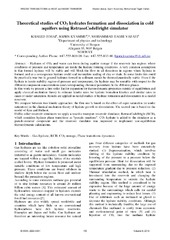| dc.contributor.author | Jemai, Khaled | eng |
| dc.contributor.author | Kvamme, Bjørn | eng |
| dc.contributor.author | Vafaei, Mohammad Taghi | eng |
| dc.date.accessioned | 2015-01-23T12:45:57Z | |
| dc.date.available | 2015-01-23T12:45:57Z | |
| dc.date.issued | 2014 | eng |
| dc.identifier.issn | 2224-3461 | en_US |
| dc.identifier.issn | 1790-5044 | en_US |
| dc.identifier.uri | https://hdl.handle.net/1956/9247 | |
| dc.description.abstract | Abstract: - Hydrates of CO2 and water can form during aquifer storage if the reservoir has regions where conditions of pressure and temperature are inside the hydrate forming conditions. A very common assumption is that formed hydrate will be stable and will block the flow in all directions in regions where hydrate is formed, and as a consequence hydrate could seal incomplete sealing of clay or shale. In some limits this could be practically true but in general hydrates formed in sediment cannot be thermodynamically stable. Even if the hydrate is inside stability region of pressure and temperature, the hydrate may be unstable with respect to the different component concentrations (and corresponding chemical potentials) in the different phases. In this work we present a first order Taylor expansion for thermodynamic properties outside of equilibrium and apply classical nucleation theory to estimate kinetic rates for hydrate formation kinetics and similar rates in cases of under saturation. Results are applied in model studies of hydrate formation and dissociation in a model reservoir. We compare between two kinetic approaches: the first one is based on the effect of super saturation (or under saturation) in the classical nucleation theory of hydrate growth or dissociation. The second one is based on the model of Kim and Bishnoi. Unlike other reservoir simulators we apply a reactive transport reservoir simulator, RetrasoCodeBright (RCB), which considers hydrate phase transitions as “pseudo reactions”. CO2 hydrate is added to the simulator as a pseudo-mineral component and the reservoir simulator was improved to implement non-equilibrium thermodynamic calculations. | en_US |
| dc.language.iso | eng | eng |
| dc.publisher | World Scientific and Engineering Academy and Society | en_US |
| dc.relation.ispartof | <a href="http://hdl.handle.net/1956/9248" target="_blank">Modeling Hydrate Phase Transitions in Porous Media Using a Reactive Transport Simulator</a> | en_US |
| dc.relation.ispartof | <a href="http://hdl.handle.net/1956/9698" target="_blank">Reactive transport modelling of hydrate phase transition dynamics in porous media</a> | en_US |
| dc.subject | Gas hydrate | eng |
| dc.subject | RCB | eng |
| dc.subject | CO2 storage | eng |
| dc.subject | Phase transitions dynamics | eng |
| dc.title | Theoretical studies of CO2 hydrates formation and dissociation in cold aquifers using RetrasoCodeBright simulator | en_US |
| dc.type | Peer reviewed | |
| dc.type | Journal article | |
| dc.description.version | publishedVersion | en_US |
| dc.rights.holder | Copyright 2014 The Authors. All rights reserved | en_US |
| dc.source.journal | WSEAS Transactions on Heat and Mass Transfer | |
| dc.source.40 | 9 | |
